 Back
Back
Published 2025.07.26
I have a fascination with timekeeping devices. I have what normal people would refer to as a giant collection of nice watches, and what watch collectors would refer to as a small collection of affordable watches. I intend to write about my watches at some point, but for now, I want to focus on their bigger siblings: the clocks. That's right: it's time to take inventory of all the clocks.
I got this mantel clock as a wedding present from my parents. It's probably at least one hundred years old, though I'm not sure exactly when it was made or who made it; regardless, it's a beautiful clock. It has an 8-day movement which chimes the hour. I say it has an 8-day movement but I try not to test the limits of that, so I wind it every two or three days; I've come to realize that a great inconvenience of this clock is when its chime gets out of sync with its hands, typically by the spring for the chime running out before the movement stops. The only way I know to fix that is to loosen the hour hand and reposition it according to what hour it's been chiming, or to let the spring run out and try again with a 1 in 12 chance. So, when I've got it chiming the correct hour, I'm careful to keep it running.
This clock lives on a bookcase in the dining room surrounded by (mostly) Lego flowers.
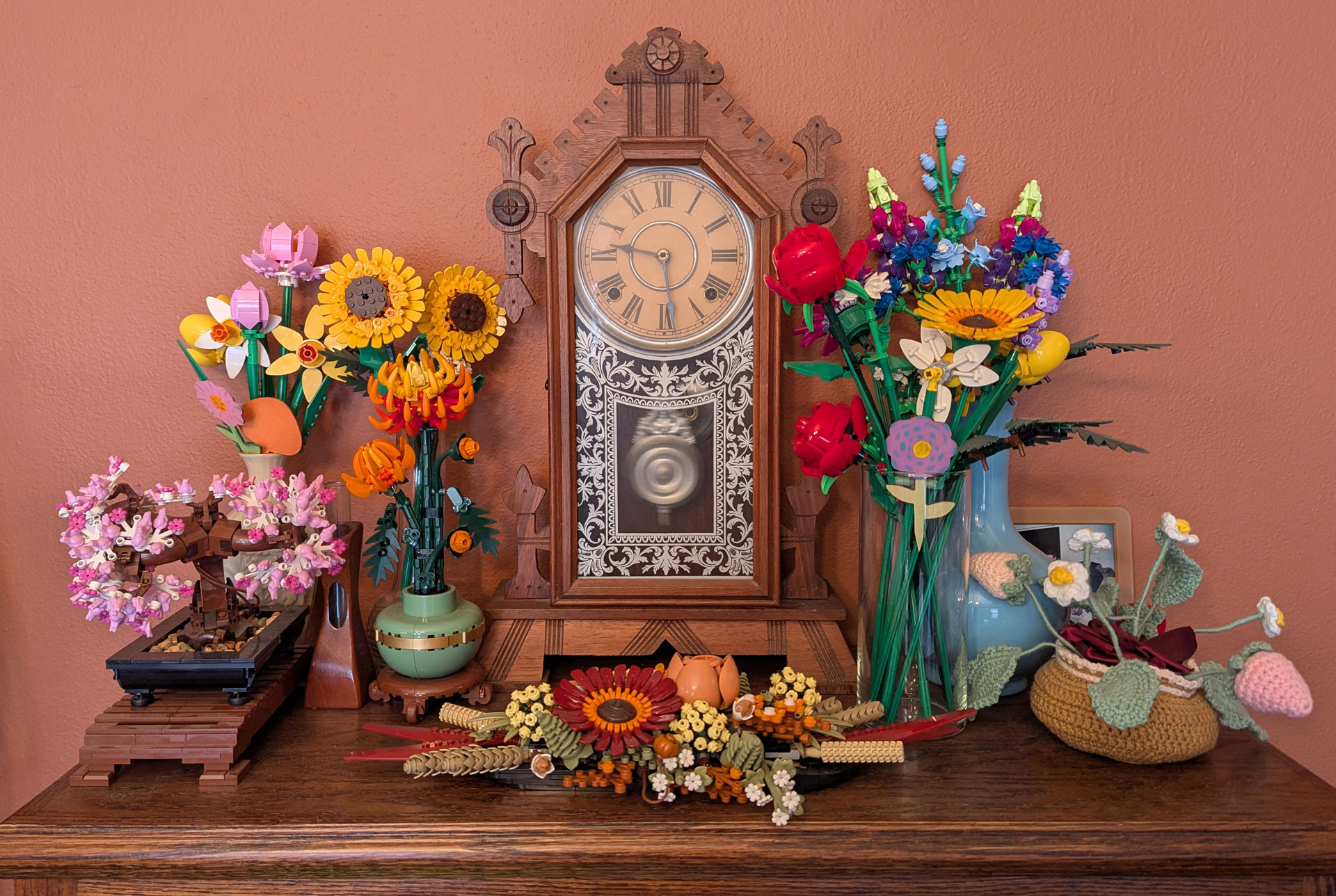
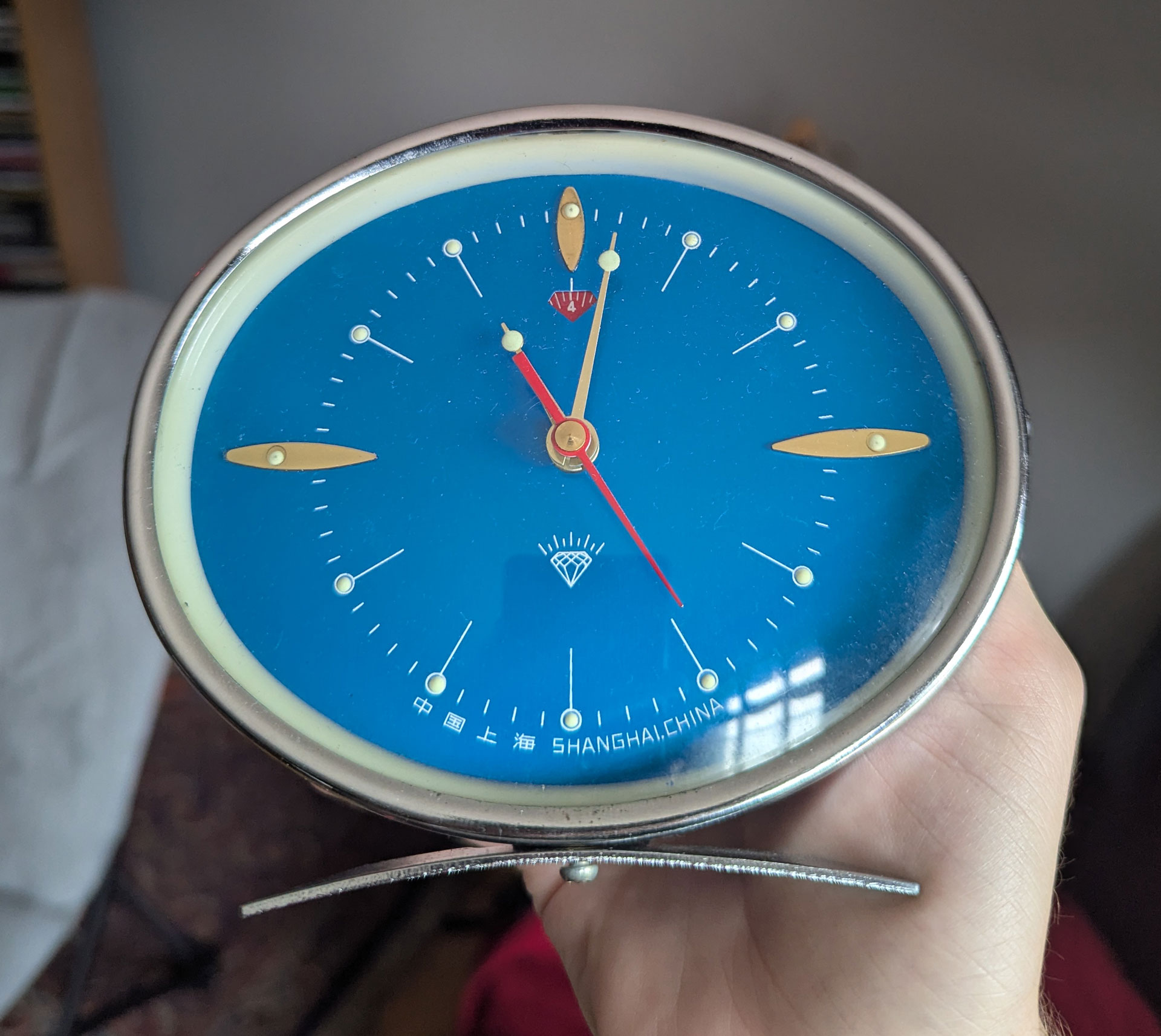
This is a mechanical alarm clock that I bought on eBay from a seller in Bulgaria. It was made by the Diamond brand in Shanghai, probably in the early 1970s. If you look online, you can find a seemingly endless number of similar models from Shanghai with this movement or similar, and a myriad of appealing vintage and novelty designs, including the famous pecking hen clock which features a pastoral scene with a chicken whose head moves with the beat of the clock. Others can be found with a seal balancing a ball that "spins" with the clock movement, or pandas whose heads tilt. Mine is a more dignified design—totally absent of any locomoting critters—but it's got a pleasing mid-century aesthetic that looks sort of like something out of the Jetsons, all round and chrome.
The movement requires daily winding, though it seems to last about 40 hours from a full wind. Interestingly for an alarm clock, it has a seconds hand, which ticks about three times per second. The alarm is set via a little diamond-shaped window beneath the twelve. Some of the Diamond alarm clocks you can find online have complications like a day or date display (typically operated by a flipping mechanism), and I've even seen one with a built-in thermometer. I've seen this clock and others from this brand described as having radium paint, but I think that's unlikely given the era, and mine certainly doesn't. While it does glow very faintly in the dark, it only does so after being charged with a light.
My Shanghai Diamond alarm clock keeps remarkably good time for an aging mechanical clock. It's more accurate than my mantel clock (which should be easier to regulate) and more accurate even than some of my cheaper quartz clocks/watches. You can regulate it via a slider on the back, and I've gotten it to the point where it seems to drift by about a minute per month. It's very stiff to adjust; I haven't taken it apart to clean it or lubricate it, and unless it stops running, I probably won't.
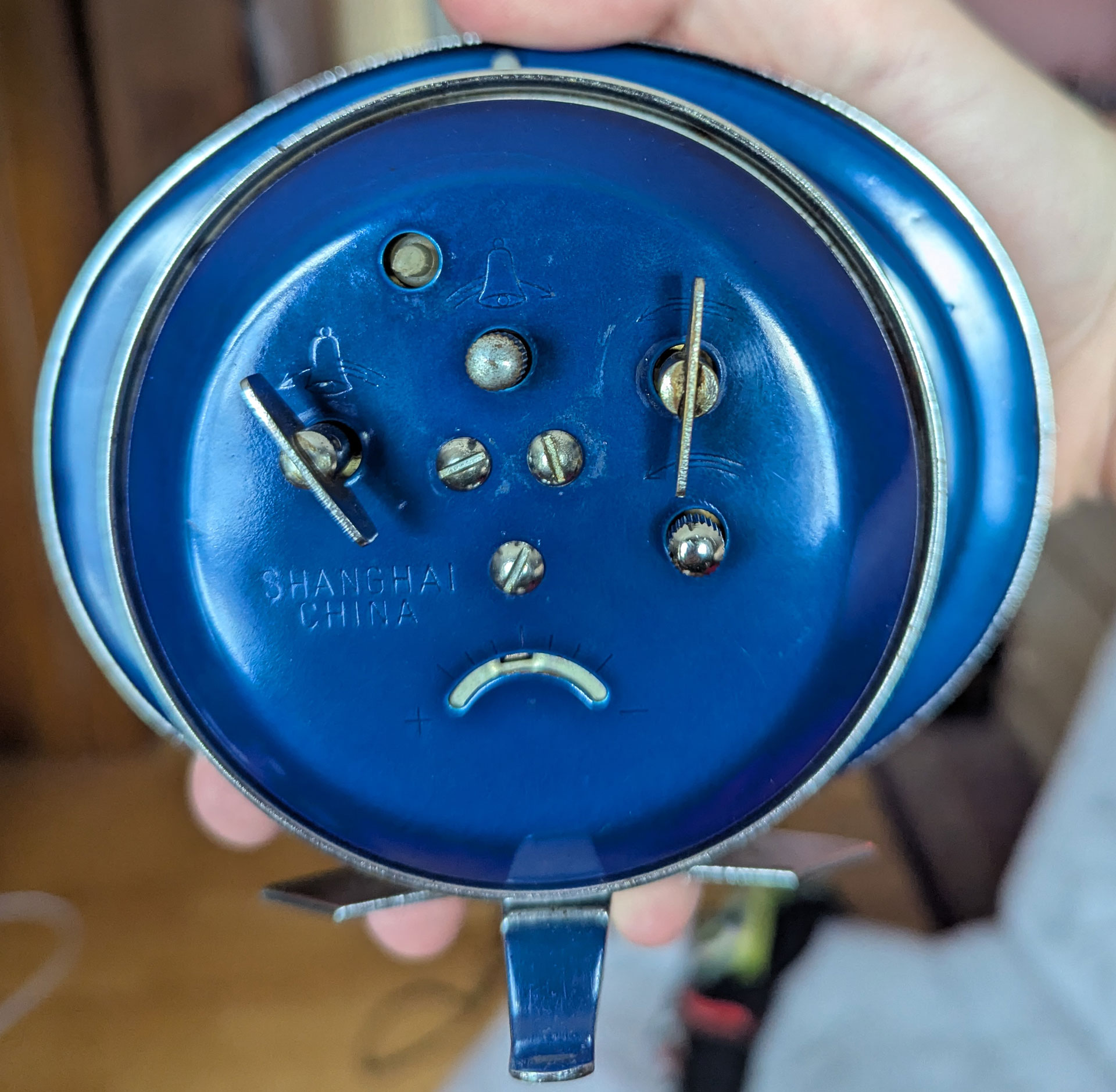
I would recommend anyone who wants a funky little clock to check out these Shanghai alarm clocks; they're cheap and easy to find, keep good time, and with so many different models I'm sure there's one that would appeal to just about anyone. What I wouldn't recommend is trying to use it as an actual alarm clock. The alarm (which is hidden inside the clock) sounds terrible—like the rattling of machine gun fire or the sputtering of a two-stroke engine—and would likely give you a heart attack waking you up; furthermore, the ticking is so loud it's liable to keep you from getting any sleep anyway.
Below is the sound of the ticking and alarm of the Shanghai Diamond alarm clock. To get an idea of just how startling it would be to have this wake you up, I've left an indeterminate period of ticking at the beginning for your enjoyment.
This clock lives in my office, sitting on my speakers between two head-shaped plant pots.
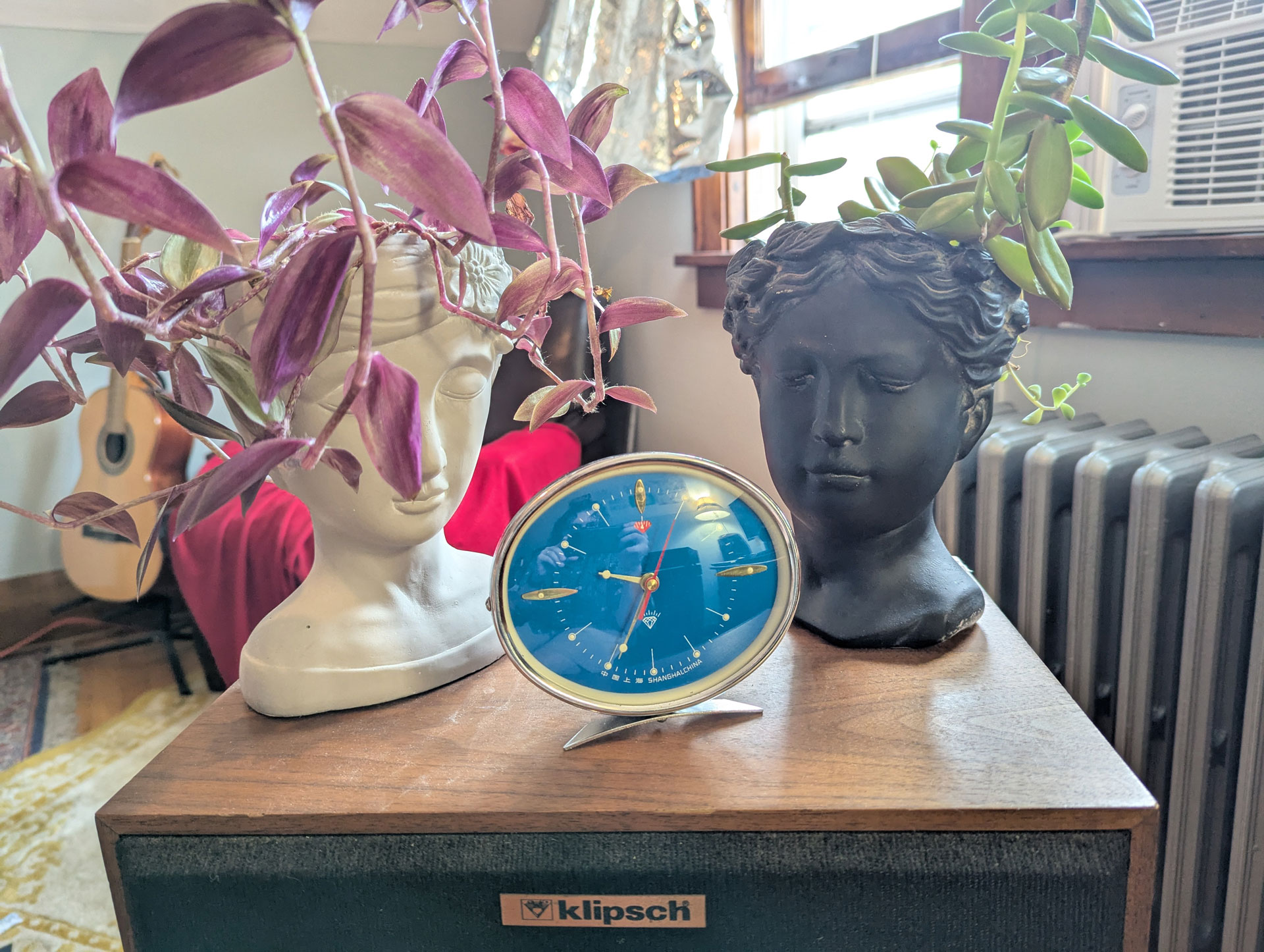
The flip clock is a unique style of clock whose design is somewhere between an analog and a digital display. They operate by flipping through a rotating stack of cards with the times printed on them, similar to the mechanism behind a rolodex. This flip clock was a birthday present from my brother four or five years ago. This is the ubiquitous design of affordable flip clocks available online today and sold under many brand names. It takes a single D Cell battery, which will power it for a few years until it eventually starts to slow down as the battery dies.
A word of caution to those interested in such a flip clock; they make a lot of noise, and different noises than a typical clock. Rather than regular ticking on the second, these flip clocks make a sort of high frequency clicking sound as the gears turn continuously. Every minute they make a quiet, pleasant flip sound as the new minute drops, but every hour they make a louder sound which I can hear from other rooms in the house as they drop the next hour. The movement isn't particularly accurate either; I find myself adjusting it every month or so when I find it's off by a minute or two.
This clock lives on top of my dresser next to a lava lamp and a picture of Nancy riding a "hoverboard" which I drew myself based on the infamous Olivia Jaimes panel from 2018 and is colored in via typewriter with the immortal quip: Sluggo Is Lit.
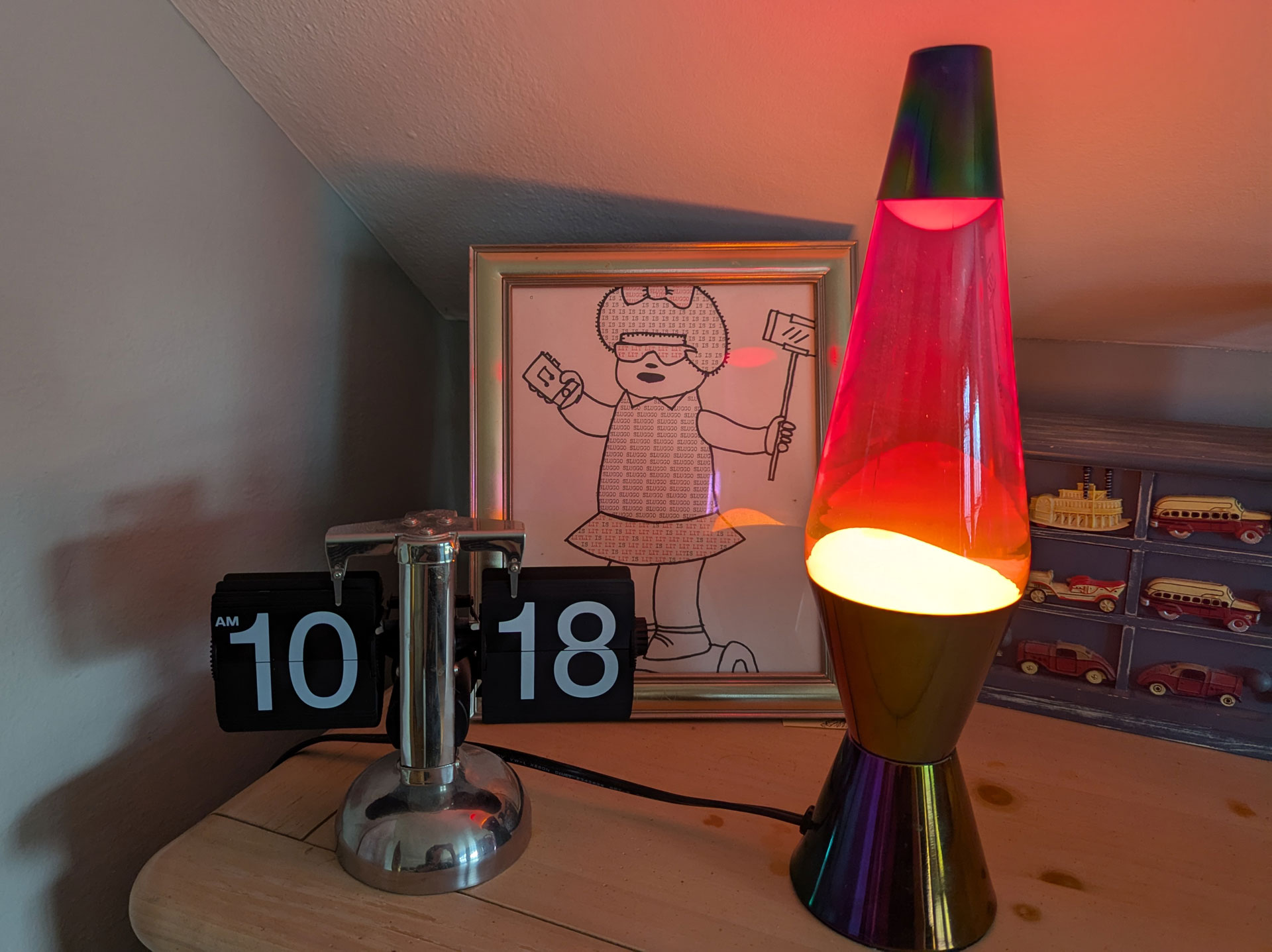
This classy modern mantel clock made by Howard Miller was also a wedding present and is meant to look like an antique but is powered by a quartz movement and keeps excellent time with no winding. The dial is very similar to my antique mantel clock, with roman numerals and a similar train track for the minutes.
It lives on the buffet underneath the cow, between two photographs.
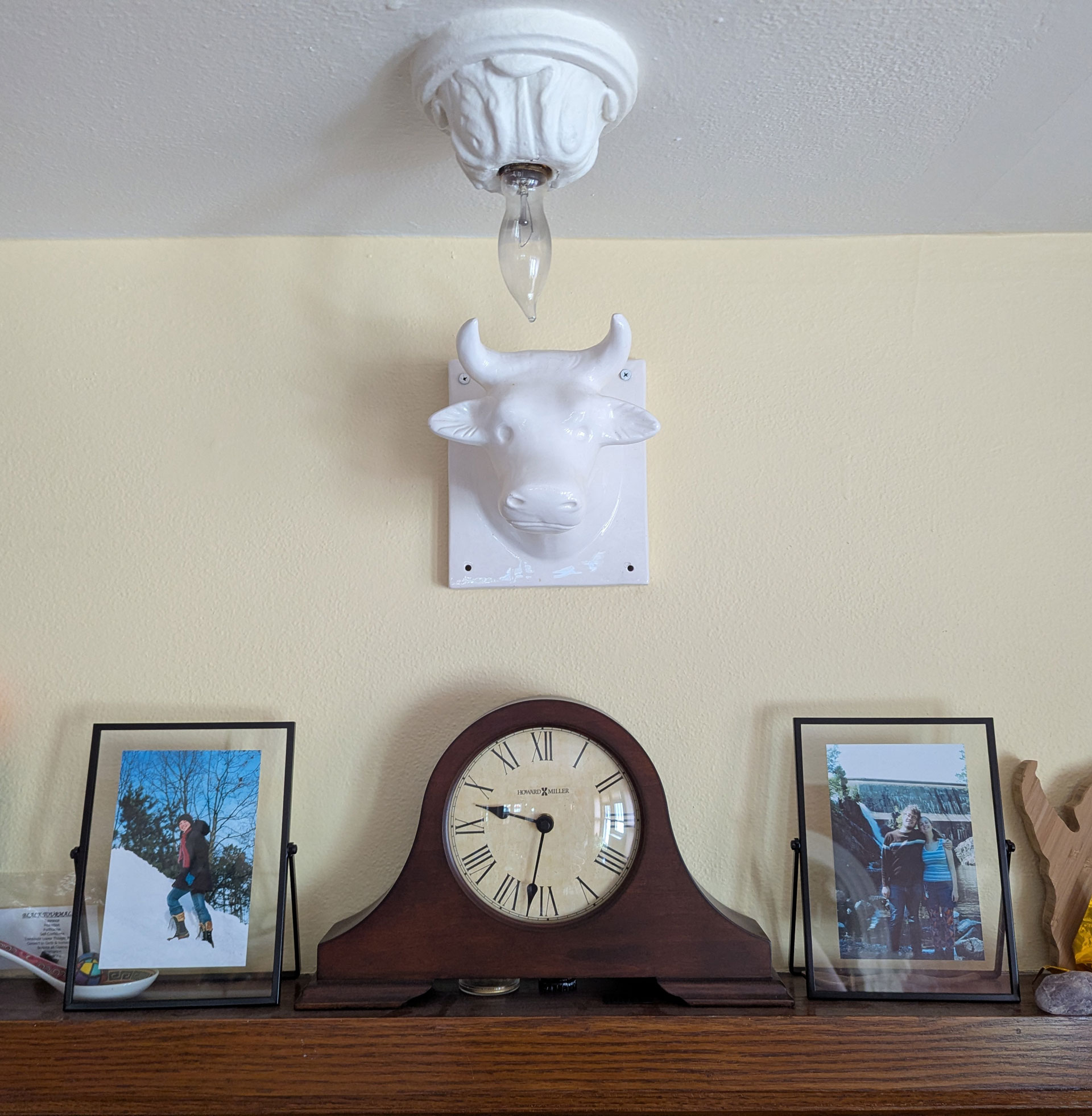
I made this wall clock on New Years Eve 2024 to ring in the new year. It is made of cardboard and pink construction paper, which I wrote on using a silver and black sharpie (actually a Milwaukee Tool Inkzall fine point silver marker). I had the clock movement sitting around for many years and decided spur of the moment to make a clock, which I had never done before. Its main feature is that the minute and hour hands have the numbers "20" and "25" written on them respectively, such that at midnight they line up to read "2025". I may have to chop off the numbers when the year is over; or maybe I will keep it intact as a quaint reminder of when it was made.
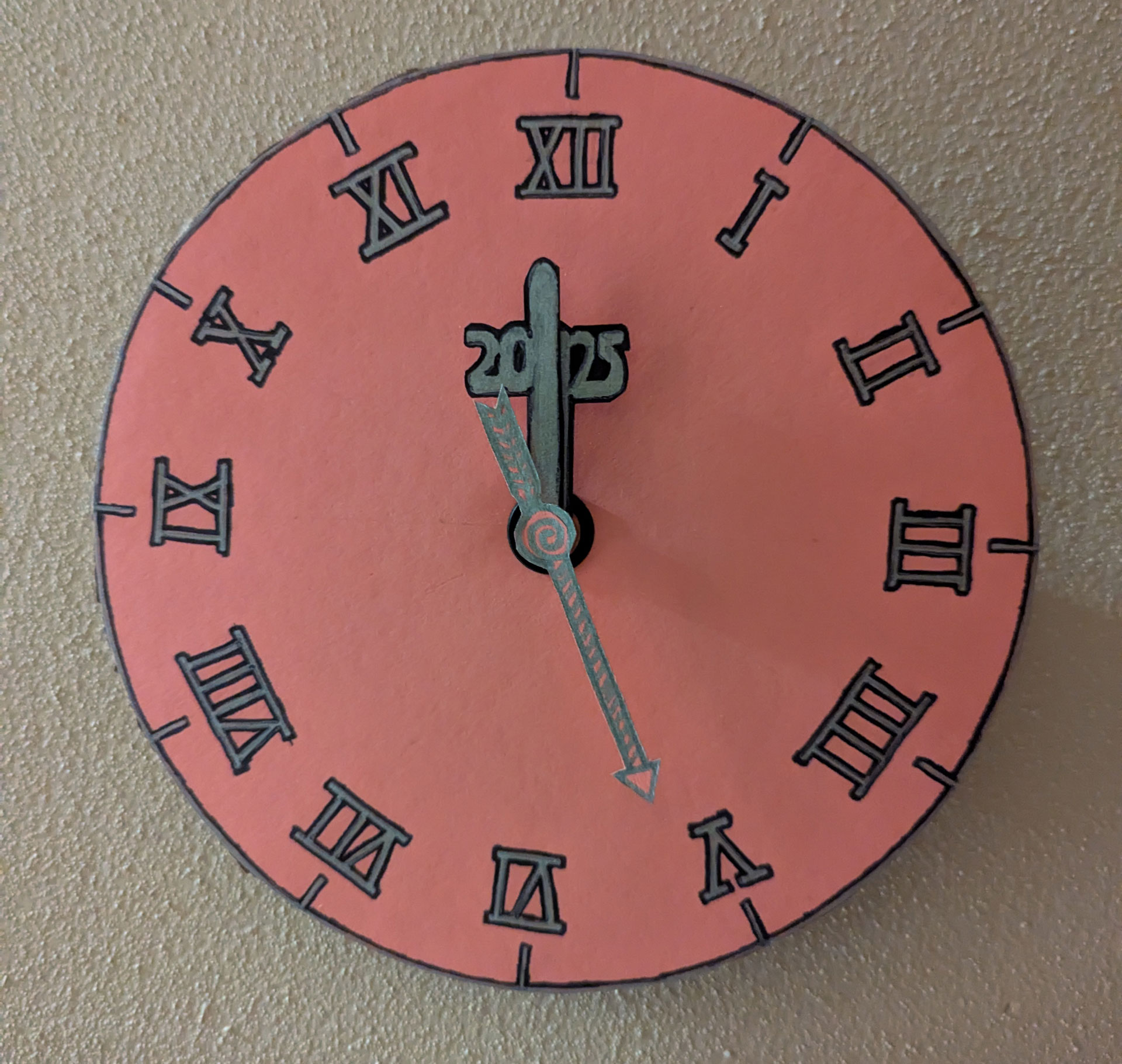
This clock lives in the stairway above the door to the first floor.
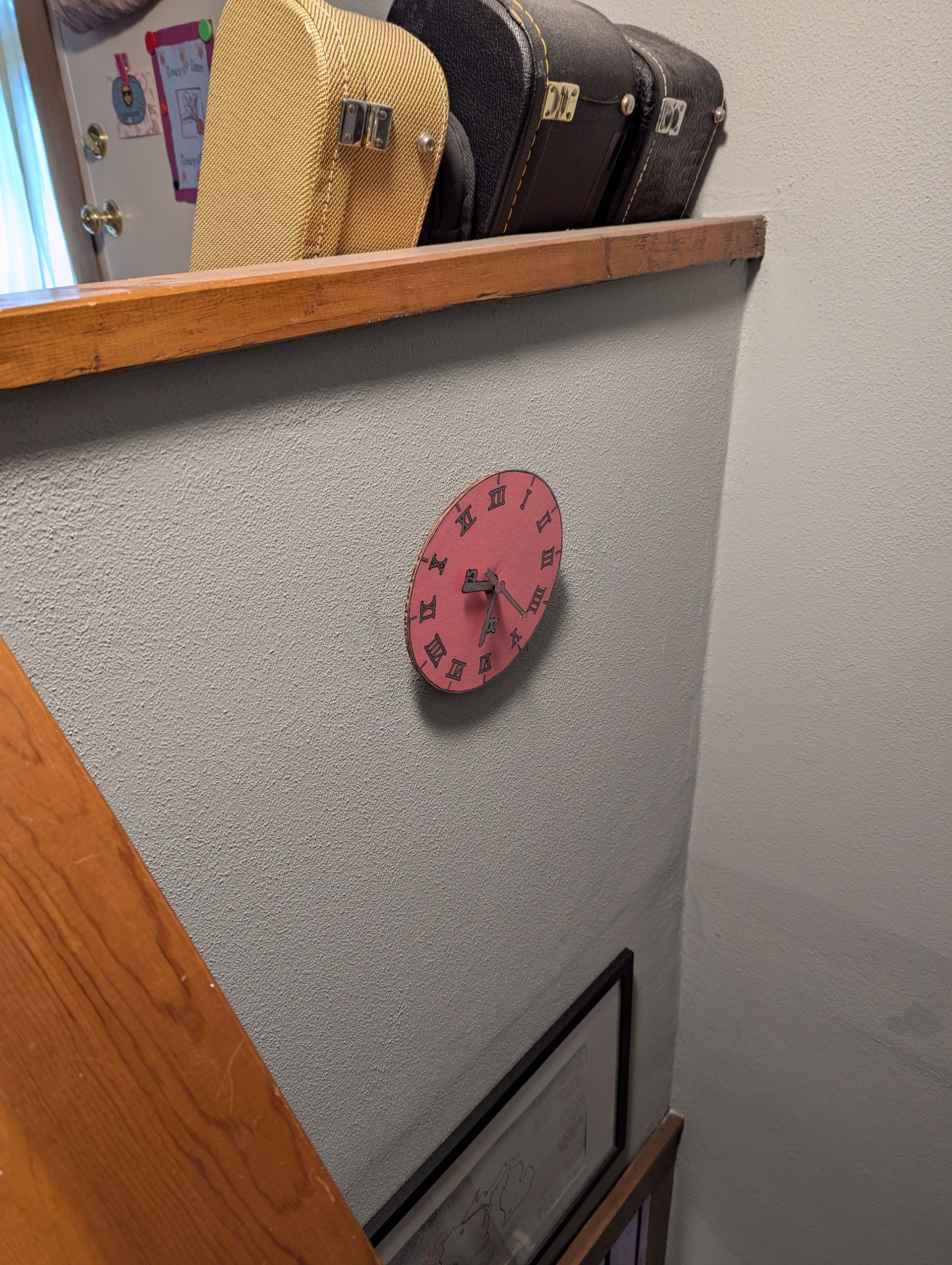
This wall clock was my second attempt at clockmaking, which I made in February of this year. It features a higher quality radio-controlled movement that syncs to the time signal. It is constructed out of a small wooden tray (of whose origins I am uncertain), construction paper, HVAC tape, and green glow-in-the-dark paint which I hoped would be more impressive but turned out disappointingly feeble.
I made two major mistakes when putting this one together:
Despite that, I do like how it looks and think it turned out acceptably.
This clock lives on the bedroom wall, over the bedside table; I had hoped to be able to read the time in the dark, but the light doesn't last long.
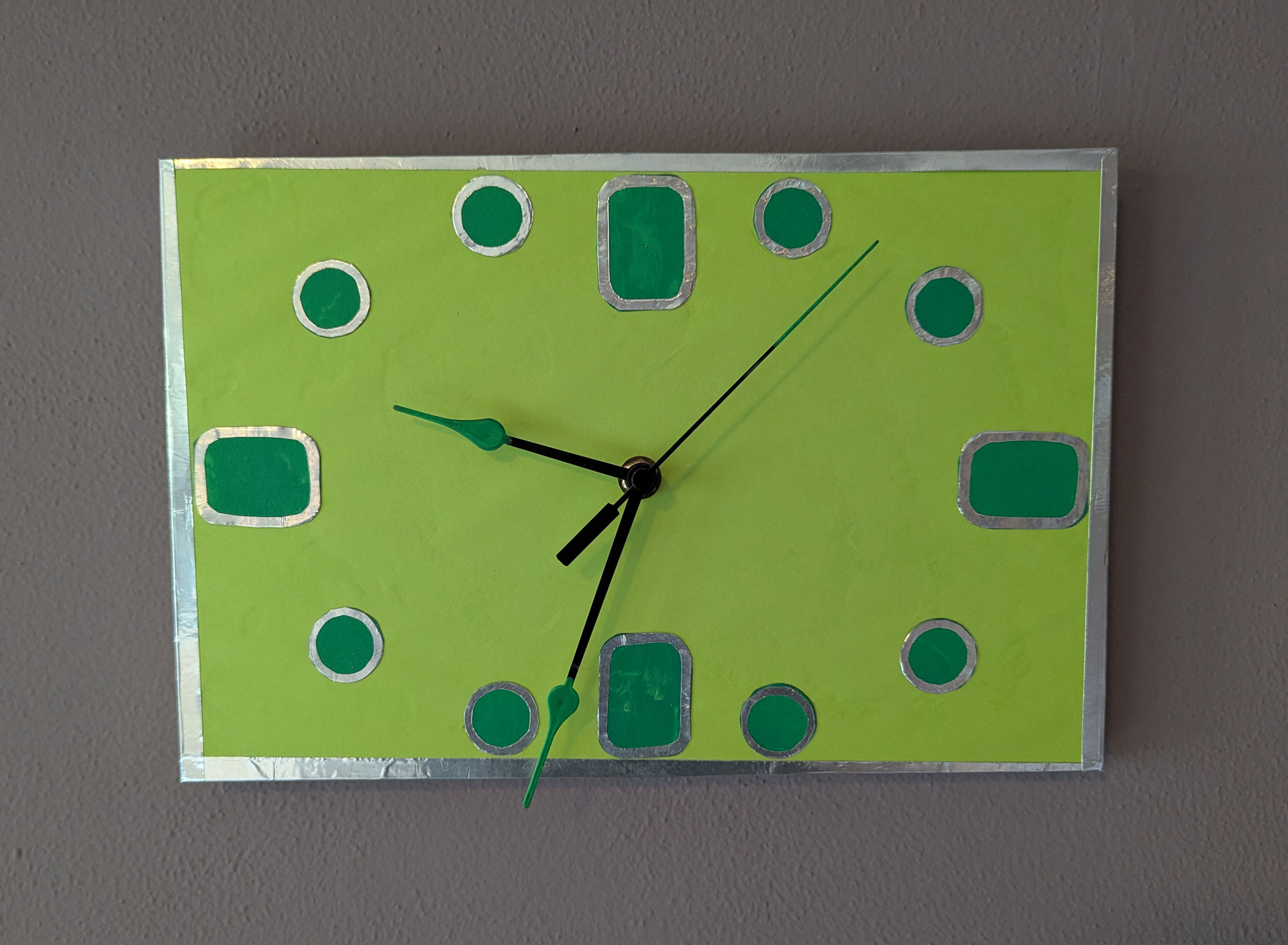
Both my oven and microwave have clocks on them. I don't think any of my other kitchen appliances do. Many other appliances have timers but not clocks. Let's hear it for the oven and microwave clocks of the world; without them, many of us would never know if we lost power in the middle of the night.
Kitchen appliances with clocks: 2
There's a couple of cars in my garage: a 2008 Toyota Rav4, and a 2011 Toyota Camry, both with state-of-the-art digital clocks in them, among many other fabulous features like CD players, seatbelts, cupholders, and windshield wipers.
Automobiles with clocks: 2
There's a number of other electronic devices which display the time in my house. It's hard to know where to draw the line here, but I'm going to go with devices that:
In terms of personal computers, there are two desktop computers and three laptops in my home typically. Along those lines, we also have: a Steam Deck, a Nintendo Switch, and a couple of TVs with so-called "smart" features. That's 9 clocks from large consumer electronics.
There's a clock radio on a bedside table which belongs to my wife.
The big one I've omitted thus far is the thermostat, which of course displays the time and can be used to schedule different temperature settings.
I intermittently use outlet timers, which are clocks (they do display the current time) and not simple timers. These count by most of these criteria but may or may not fit in your pocket. I'm going to say they count because they won't work unless they're not in your pocket, and the prongs would poke you if you put them in your pocket. I have two of them and specifically during the holidays have used both simultaneously.
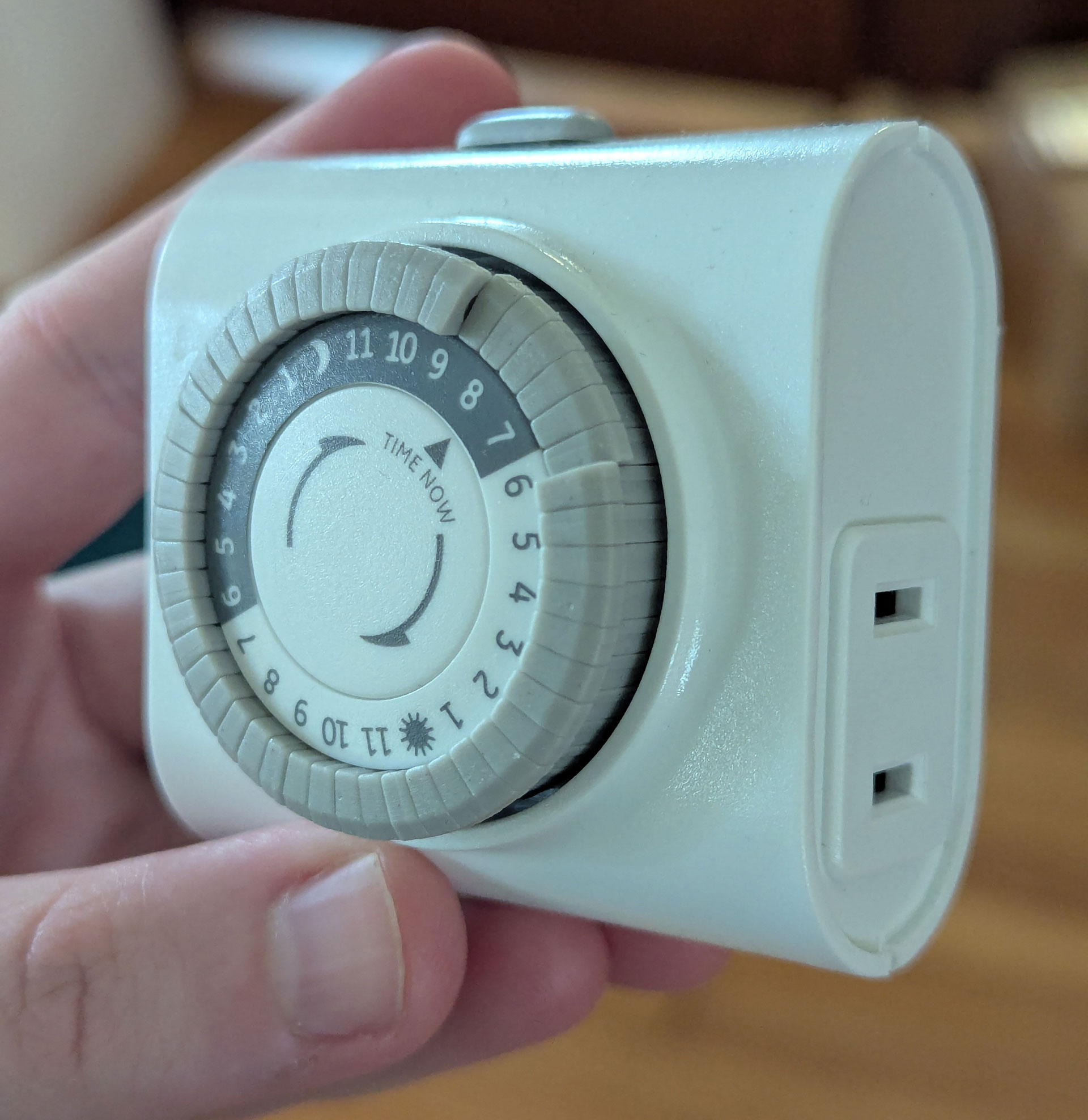
Miscellaneous items with clocks: 13
I guess there's about 23 clocks in my house, depending on what you count as a clock. By looser criteria, the number would surely explode and become difficult to ascertain. At one point not long ago, a clock was one of, if not the, most valuable and important possessions a household would own; nowadays we almost all have more clocks than we know what to do with and rarely take inventory of our clocks.
I've known people with both more and fewer clocks than me. Some people have walls in their house dedicated to displaying innumerable clocks. Likewise, you could easily make do with zero clocks these days; I know most people (myself included) use their phone as an alarm clock. I like all timekeeping devices, and definitely collect watches, but I'm not sure if I would call myself a clock collector. If there's one thing we can all agree on, though, it's that changing the clocks for daylight savings time is ridiculous and we should stop doing it.